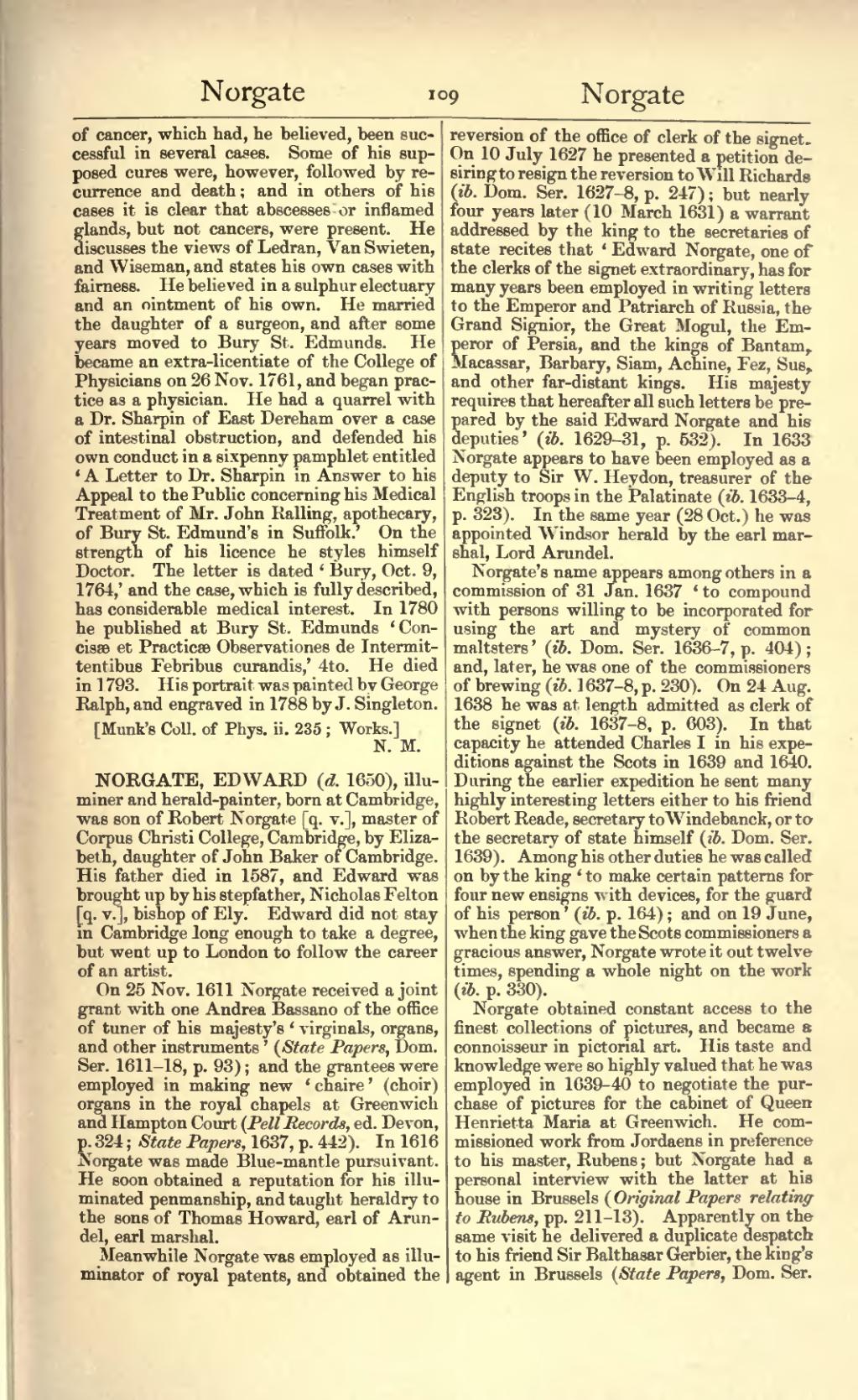of cancer, which had, he believed, been successful in several cases. Some of his supposed cures were, however, followed by recurrence and death; and in others of his cases it is clear that abscesses or inflamed glands, but not cancers, were present. He discusses the views of Ledran, Van Swieten, and Wiseman, and states his own cases with fairness. He believed in a sulphur electuary and an ointment of his own. He married the daughter of a surgeon, and after some years moved to Bury St. Edmunds. He became an extra-licentiate of the College of Physicians on 26 Nov. 1761, and began practice as a physician. He had a quarrel with a Dr. Sharpin of East Dereham over a case of intestinal obstruction, and defended his own conduct in a sixpenny pamphlet entitled ‘A Letter to Dr. Sharpin in Answer to his Appeal to the Public concerning his Medical Treatment of Mr. John Ralling, apothecary, of Bury St. Edmund's in Suffolk.’ On the strength of his licence he styles himself Doctor. The letter is dated ‘Bury, Oct. 9, 1764,’ and the case, which is fully described, has considerable medical interest. In 1780 he published at Bury St. Edmunds ‘Concisæ et Practicæ Observationes de Intermittentibus Febribus curandis,’ 4to. He died in 1793. His portrait was painted by George Ralph, and engraved in 1788 by J. Singleton.
[Munk's Coll. of Phys. ii. 235; Works.]
NORGATE, EDWARD (d. 1650), illuminer and herald-painter, born at Cambridge, was son of Robert Norgate [q. v.], master of Corpus Christi College, Cambridge, by Elizabeth, daughter of John Baker of Cambridge. His father died in 1587, and Edward was brought up by his stepfather, Nicholas Felton [q. v.], bishop of Ely. Edward did not stay in Cambridge long enough to take a degree, but went up to London to follow the career of an artist.
On 25 Nov. 1611 Norgate received a joint grant with one Andrea Bassano of the office of tuner of his majesty's ‘virginals, organs, and other instruments’ (State Papers, Dom. Ser. 1611–18, p. 93); and the grantees were employed in making new ‘chaire’ (choir) organs in the royal chapels at Greenwich and Hampton Court (Pell Records, ed. Devon, p. 324; State Papers, 1637, p. 442). In 1616 Norgate was made Blue-mantle pursuivant. He soon obtained a reputation for his illuminated penmanship, and taught heraldry to the sons of Thomas Howard, earl of Arundel, earl marshal.
Meanwhile Norgate was employed as illuminator of royal patents, and obtained the reversion of the office of clerk of the signet. On 10 July 1627 he presented a petition desiring to resign the reversion to Will Richards (ib. Dom. Ser. 1627–8, p. 247); but nearly four years later (10 March 1631) a warrant addressed by the king to the secretaries of state recites that ‘Edward Norgate, one of the clerks of the signet extraordinary, has for many years been employed in writing letters to the Emperor and Patriarch of Russia, the Grand Signior, the Great Mogul, the Emperor of Persia, and the kings of Bantam, Macassar, Barbary, Siam, Achine, Fez, Sus, and other far-distant kings. His majesty requires that hereafter all such letters be prepared by the said Edward Norgate and his deputies’ (ib. 1629–31, p. 532). In 1633 Norgate appears to have been employed as a deputy to Sir W. Heydon, treasurer of the English troops in the Palatinate (ib. 1633–4, p. 323). In the same year (28 Oct.) he was appointed Windsor herald by the earl marshal, Lord Arundel.
Norgate's name appears among others in a commission of 31 Jan. 1637 ‘to compound with persons willing to be incorporated for using the art and mystery of common maltsters’ (ib. Dom. Ser. 1636–7, p. 404); and, later, he was one of the commissioners of brewing (ib. 1637–8, p. 230). On 24 Aug. 1638 he was at length admitted as clerk of the signet (ib. 1637–8, p. 603). In that capacity he attended Charles I in his expeditions against the Scots in 1639 and 1640. During the earlier expedition he sent many highly interesting letters either to his friend Robert Reade, secretary to Windebanck, or to the secretary of state himself (ib. Dom. Ser. 1639). Among his other duties he was called on by the king ‘to make certain patterns for four new ensigns with devices, for the guard of his person’ (ib. p. 164); and on 19 June, when the king gave the Scots commissioners a gracious answer, Norgate wrote it out twelve times, spending a whole night on the work (ib. p. 330).
Norgate obtained constant access to the finest collections of pictures, and became a connoisseur in pictorial art. His taste and knowledge were so highly valued that he was employed in 1639–40 to negotiate the purchase of pictures for the cabinet of Queen Henrietta Maria at Greenwich. He commissioned work from Jordaens in preference to his master, Rubens; but Norgate had a personal interview with the latter at his house in Brussels (Original Papers relating to Rubens, pp. 211–13). Apparently on the same visit he delivered a duplicate despatch to his friend Sir Balthasar Gerbier, the king's agent in Brussels (State Papers, Dom. Ser.
